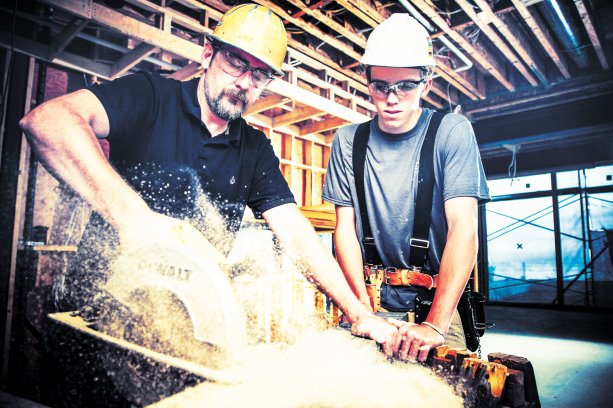The MUSH group is pretty mushy when it comes to hiring apprentices, according to figures collected by the British Columbia and Yukon Territory Building and Construction Trades Council.
B.C. Building Trades executive director Tom Sigurdson said B.C.’s municipalities, universities and colleges, schools, and hospitals (known as the MUSH group and includes crown corporations) employ very few skilled labour apprentices at a time when apprentices are struggling to find sponsors and government has encouraged young people to opt into trades.
"The number has increased," he said, but the numbers are still "horrible".
When all apprentices at all levels are counted, the B.C.’s MUSH group numbers rose from 304 to 361 during the past year, with BC Hydro still the major employer of apprentices.
"BC Hydro employs 184," said Sigurdson. "So, if you take those apprentices out of the picture, we are not doing very well at all."
Sigurdson said he does not want to disparage other trades but that cumulative MUSH tally also includes apprentice cooks hired by crown entities such as BC Ferries and arborists within municipalities. While cooks are needed in construction camps, more focus is needed on construction trades where there is a looming skills shortage.
Sigurdson wants to see B.C. move back to compulsory trades, which were abolished when the Industry Training Authority of B.C. (ITA BC) was founded.
B.C. is the only Canadian province which does not have compulsory trades requiring work to be done by an apprentice or journey person.
"Contractors will hire an unskilled worker who is really doing the work that a first or second year apprentice should be doing," he said, adding that employer can pay less and escape paying benefit. But, also individuals doing this work are not registered with any union or apprentice system and do not receive credit for their work hours. Utilizing workers in this way provides cheap labour for the company but does nothing to enhanced skill levels in B.C.’s workforce, he said.
Randy Callaghan, who has been honoured with various industry awards for his work in the education field, speaks to highschools and post-secondary classes throughout the Lower Mainland regarding construction opportunities. Callaghan, who is responsible for PCL Construction’s trades and skills recruitment, said that job opportunities for apprentices appear slim this summer.
He recently attended two foundation courses at a post-secondary institution and asked how many students had jobs lined up? "One person had a job lined up and that was with a family business," he said, adding that graduation was only four days away. "That is the worst I have ever seen it."
He said students emerging from foundation courses looking for apprenticeships sponsors usually have more opportunity. "There should be a line-up of employers," he said, especially as skilled labourers are also short in demand. While hiring a first-year apprentice has a front end cost, it is later recouped by the company in later years.
Callaghan said: "If you don’t hire a first year, you won’t have a second year apprentice."
Currently, PCL Construction’s workforce is 35-40 per cent apprentices, he said, adding that some earlier apprentices-cum-journeyman are now project supervisors within the company.
Callaghan said that the slow job market for apprentices may be influenced by Alberta’s slow down as B.C. employees who worked in the oil and gas sector have taken more domestic work.
But, employers need to realize that if they do not support the young people coming out of the foundation courses, they going to scrambling for skilled labour in the future, he said, especially when the Alberta oil patch rebounds.
"We always need to more employers to step up to hire apprentices," agrees ITA BC’s CEO Gary Herman. "It is a situation that exists right across Canada."
He said ITA BC figures show 37,000 registered apprentices in BC’s skilled trades training system and only 9,400 registered employer sponsors. Within the next 10 years, more than one million jobs will be available in B.C. with two-thirds of those created by baby-boomers leaving the workforce.
In terms of skilled labour filling those vacant job posts, B.C. is facing a shortfall of qualified individuals, Herman said.
The ITA BC has launched new initiatives directed at encouraging employers to hire apprentices. Its website is featuring the WorkBC Job Match tool where individuals can identify themselves as apprentices and be matched up with employers who require a person at their skill level. "Currently, there are 11,700 apprentices registered with the Job Match tool and it is a great way for employers to find apprentices," Herman said.
He said the ITA BC has also entered into an agreement with the BC Chamber of Commerce, considered B.C.’s largest and broadest business organization, to promote apprentices to their member boards.
He said that the move recognizes that individuals may not find full time work with one employer, but other employers within the local Chamber of Commerce might assist in hiring that individual.
It has also been shown that apprentices who become journeyman working in a city, often remain their either with an employer or starting a new business in that city.
But, Phil Hochstein, president of the Independent Contractors and Businesses Association, wants to see more done. "We need to continue to get projects over the finish line," he said, adding that pipelines and LNG projects need to get started.
"When there is a work opportunity, young people will be hired." B.C. needs larger projects to employ the senior skill levels required to mentor apprentices. "If you don’t have the skilled labour jobs, you can’t hire the unskilled people and train them," he said.
Organizations such as the ITA BC have also got to be more creative in placing apprentices with employers, Hochstein said.
"The ITA has to stop blaming customers and look at itself. Maybe it has to introduce more flexibility into the system for students. These grant programs of $2,000-$3,000 are not going to convince an employer to hire a student. The ITA needs to be more innovative and different — think outside the box," he said.
Wayne Hand, dean, School of Construction and the Environment at the British Columbia Institute of Technology, said the amount of young people finding jobs coming from foundation courses is similar to 18 months ago but hiring is impacted by economic factors. Metal fabrication and electrician apprentices are in demand.
"We are seeing these areas as strong," he said but areas such as boilermaker and welder are soft. "But, that doesn’t surprise me."
Boilermaker is a limited field and Alberta’s downturn not only impacted job openings such as welders and jobs that relate to the oil patch. It also returned skilled labour to B.C. limiting the number of vacancies.
Despite fluctuation of current demand, he said, the bottom line remains that that the impact of the retirement wave is "not going away".
Herman said the ITA BC is taking a long to medium-range view of replacing the aging skilled labour pool adding that companies such as Mott Electric GP, Houle Electric, PCL Construction, and others are known to hire apprentices and are grooming the next generation of skilled labour and leaders to guarantee the success their companies.
"The message is the employee is really about succession planning. It is the time to bring on the apprentices and make sure there is a seamless transfer of knowledge," Herman said. "If you do not do that and if you are a construction company when the oil and gas sector goes back up and the LNG projects move forward, there is going to be a huge demand for construction trades. The whole thing can turn pretty fast on you."

More employers who can mentor and train apprentices are needed in British Columbia and B.C. Building Trades figures indicate that the MUSH group needs to increase its role in training the next generation of journeyman. ITA BC estimates that over the next decade, a million jobs will be needed to be filled in B.C. with market growth and retirement. Construction trade skills are expected to be in high demand.
Photo: Courtesy of ITA BC"










Recent Comments
comments for this post are closed